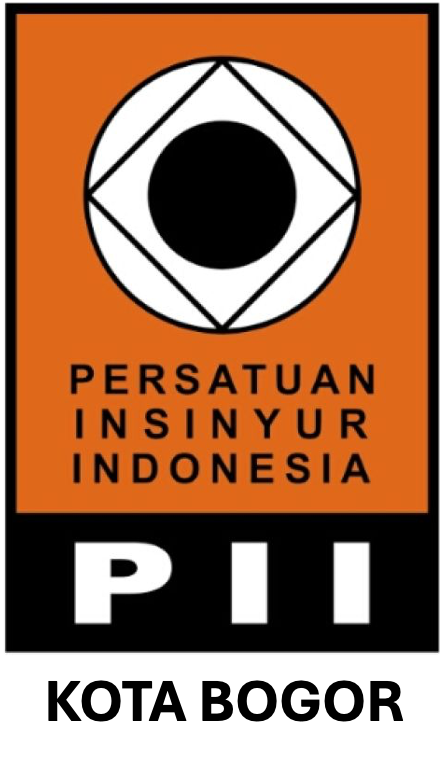Desain Kolam Retensi Berbantu Komputer di Cibuluh Kota Bogor
Abstract
Water retention serves to control the surface runoff and conservation of rainwater in maintaining groundwater accumulation. This research aims to know the discharge of flood, know the volume of water to be accommodated in water retention, determine optimal water retention volume capacity, produce an effective design of water retention technical design, and produce a cost budget plan. Research conducted in Cibuluh Quarter, Tanah Baru Village, District Bogor Utara, Bogor City, West Java. Komulative flood discharge is 12.01 m3/sec. Capacity of Ciheuleut River is 9.38 m3/sec. Total capacity of water retention is 5272.52 m3. The Capacity development is 10481 m2. Water retention area that can be constructed is 4241 m2. The depth is 4 m so the capacity is 16964 m3. The structure is oval. The shortest diameter dimension is 50 m and the longest is 108 m. Total depth plan of 6 m is able to accommodate maximum 25446 m3 of water. Planned a type of sluice with width 1300 mm x height 1600 mm with a discharge of 4.89 m3/sec. It takes a total of 5 sluices on inlet and outlet. The cost required in the construction of Cibuluh Water Retention is Rp13.680.570.000,00.
Downloads
References
Astuti D, Siswanto, Suprayogi I. 2016. Analisis kolam retensi sebagai pengendalian banjir genangan di Kecamatan Payung Sekaki. Jom Fteknik. 2(2):1-14.
[Bappeda] Badan Perencanaan Pembangunan Daerah Kota Bogor. 2018. Laporan Sinkronasi Penyusunan Masterplan Drainase (2016-2018). Bogor (ID): Badan Perencanaan Pembangunan Daerah Kota Bogor.
[BSN] Badan Standardisasi Nasional. 2016. Tata cara perhitungan debit banjir rencana. SNI 2415:2016. Jakarta (ID): Badan Standardisasi Nasional.
[DPU] Departemen Pekerjaan Umum. 2010. Tata Cara Pembuatan Kolam Retensi dan Polder dengan Saluran-Saluran Utama. Jakarta (ID): Departemen Pekerjaan Umum.
[DPUPR] Dinas Pekerjaan Umum dan Penataan Ruang Kota Bogor. 2018. Review DED Kolam Retensi Cibuluh. Bogor (ID): Dinas Pekerjaan Umum dan Penataan Ruang Kota Bogor.
Fahmiahsan R, Mudjiatko, Rinaldi. 2018. Fenomena hidrolik pada pintu sorong. Jom Fteknik. 5(1):1-10.
Florince, Arifaini N, Adha I. 2015. Studi kolam retensi sebagai upaya pengendalian banjir Sungai Way Simpur Kelurahan Palapa Kecamatan Tanjung Karang Pusat. JRSDD. 3(3):507-520.
[KemenKeu] Kementrian Keuangan. 2010. Persandingan Susunan dalam Satu Naskah Undang-Undang Pajak Pertambahan Nilai Barang dan Jasa dan Pajak Penjualan atas Barang Mewah 2009. Jakarta (ID): Kementrian Keuangan.
[KemenPU] Kementrian Pekerjaan Umum. 2014. Penyelenggaraan sistem drainase perkotaan.Peraturan Menteri Pekerjaan Umum nomor 12/PRT/M/2014. Jakarta (ID): Kementrian Pekerjaan Umum.
[P3SDAK] Pusat Pendidikan dan Pelatihan Sumberdaya Air dan Konstruksi. 2018. Analisis Hidrologi dan Sedimen. Bandung (ID) : Pusat Pendidikan dan Pelatihan Sumberdaya Air dan Konstruksi.
Saputra IK. 2017. Perhitungan intensitas hujan berdasarkan data curah hujan stasiun curah hujan di Kota Denpasar [skripsi]. Denpasar (ID): Universitas Udayana.
Sebastian L. 2008. Pendekatan pencegahan dan penanggulangan banjir. Dinamika Teknik Sipil. 8(2):162-169.
Soemarto CD. 1999. Hidrologi Teknik. Jakarta (ID): Erlangga.
Yulius E. 2014. Analisa curah hujan dalam membuat kurva intensity duration frequency (IDF) pada DAS Bekasi. Jurnal Bentang. 2(1):1-8.
Copyright (c) 2020 Jurnal Teknik Sipil dan Lingkungan

This work is licensed under a Creative Commons Attribution-NonCommercial-NoDerivatives 4.0 International License.
Authors who publish with Jurnal Teknik Sipil dan Lingkungan, JSIL agree to the following terms:
a. Authors retain copyright and grant the journal right of first publication with the work simultaneously licensed under a Creative Commons Attribution License that allows others to share the work with an acknowledgment of the work's authorship and initial publication in this journal.
b. Authors are able to enter into separate, additional contractual arrangements for the non-exclusive distribution of the journal's published version of the work (e.g., post it to an institutional repository or publish it in a book), with an acknowledgment of its initial publication in this journal.
c. Authors are permitted and encouraged to post their work online (e.g., in institutional repositories or on their website) prior to and during the submission process, as it can lead to productive exchanges, as well as earlier and greater citation of published work (See The Effect of Open Access).











